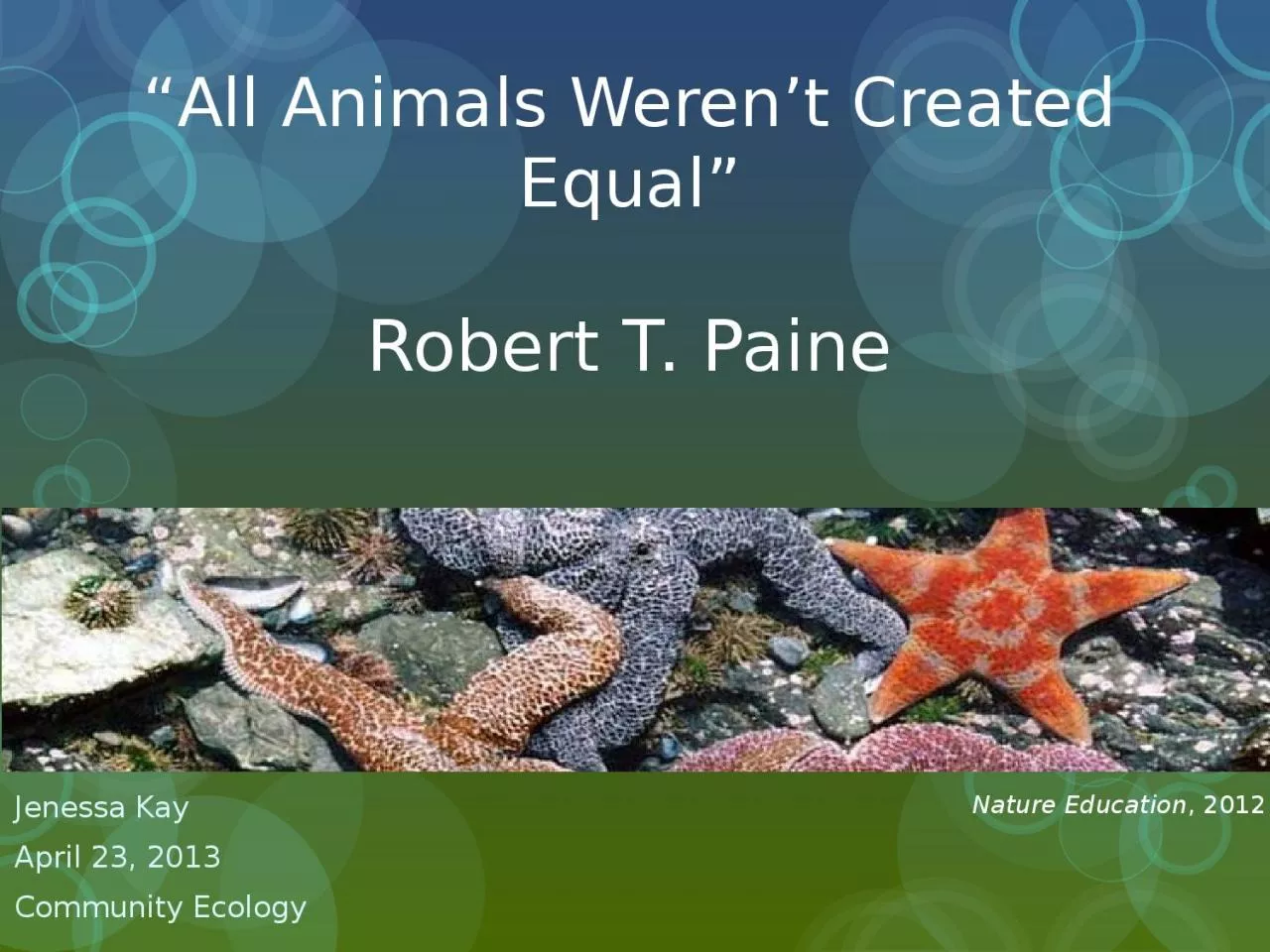

Robert T Paine Jenessa Kay April 23 2013 Community Ecology Nature Education 2012 Biographical Info Born in Cambridge MA April 131933 Happy belated birthday AB Harvard University ID: 1018056
Download Presentation The PPT/PDF document "“All Animals Weren’t Created Equal�..." is the property of its rightful owner. Permission is granted to download and print the materials on this web site for personal, non-commercial use only, and to display it on your personal computer provided you do not modify the materials and that you retain all copyright notices contained in the materials. By downloading content from our website, you accept the terms of this agreement.
1. “All Animals Weren’t Created Equal”Robert T. PaineJenessa KayApril 23, 2013Community EcologyNature Education, 2012
2. Biographical InfoBorn in Cambridge, MA – April 13,1933Happy belated birthday!AB - Harvard University, 1954Army Battalion GardenerPhD - University of Michigan, 1961Post-doc, Scripps Institute of OceanographyProfessor of Zoology, University of Washington 1962 – 1998Current Professor emeritus of Zoology, UWKinne (ed.), 1994
3. Awards and Recognition1979-80 – President of Ecological Society of America1983 – MacArthur Award (ESA)1989 – Excellence in Ecology Prize (Ecology Inst. in Oldendorf am Luhe, Germany1997 – Sewall Wright Award (Society of American Naturalists)2000 – Eminent Ecologist AwardScientific American, 2010
4. Cited by 3652Cited by 1178BioScience, Vol. 46, No. 8 (Sep., 1996)Cited by 1017Cited by 920Cited by 776
5. Research OverviewPredation Hypothesis and Competitive HierarchiesFood Web Interactions and Trophic CascadesQuantifying interaction strengths and patch dynamicsKeystone Species Conceptmarinebio.netWhy don’t we have monocultures of good competitors??
6. The New York Times, 2012Kevin Schafer
7. Study LocationMakah Bay – mainland WATatoosh Island - 0.5 miles offshore from Cape FlatteryPart of Makah ReservationLongest ongoing study of a single area by the same scientist in the U.S.makah.comSuperstock.com
8. Tatoosh Islandhistory.noaa.gov (1943)wikimedia.comlegendsofamerica.com
9. “Whether I was stupid or foolhardy, I spent my first ten years in the intertidal in sneakers – cheap as possible.”scientificamerican.com“I have too good peripheral circulation.”
10. The New York Times, 2012
11. “His intellectual presence is so commanding that his physical presence hardly registers.”naturalhistoriesproject.org
12. “If you ask him a question…you feel the weight of an encyclopedic knowledge of scientific and natural history gathering behind his response.”naturalhistoriesproject.org
13. “What would happen if we removed the top predator from an ecosystem?”naturalhistoriesproject.org
14. “You get pretty good at throwing starfish into deeper water.”Nature, 2010California Academy of Sciencesasnailodyessy.com“I’ve always thought of myself as a wader due to my size.”
15. Kick-It-And-See EcologyChanged ecology from an observational to an experimental science3 years on Makah Bay8 x 2 m plotsRemoval of Pisaster ochraceusUnmanipulated controlTransect lines to measure density of resident macroinvertebrates and benthic algaeBruno, 2007 pptscientificamerican.com
16. What Maintains Diversity?Previously, thought diversity = ecosystem stability“Stability increases as the number of links increase” (MacArthur, 1955)“A rich fauna and flora…tends to be very stable because of multiplicity of ecological checks and balances” (Watt, 1964)Paine – absence of one individual can shift entire population into monoculture Species richness decreased from 15 to 8online.santarosa.edu
17. Nature Education, 2010Paine, 1966
18. 3 Pages That Changed the World (of Ecology)Loss can initiate trophic cascades: the rise and fall of connected species throughout the food web
19. Type of KeystonesPredators – Sea Otters, Gray WolvesPrey Mutualists – hummingbirds Hosts – Saguaro cactusParasitesModifiers – N. American BeaverPollinatorsWhere does it end?
20. Challenges include context dependency and diversity dictating keystone status1994 – United Nations’ Global Biodiversity Assessment met to identify issues and challenges with keystone species concept9 “keystone cops” including Paine, Tilman, Mary Power, Bruce MengeWritten as discussion between “Dr. Knowitall,” “Empiricist” and “Skeptic”
21. A keystone species is one that has a disproportionately large effect on its environment relative to its abundance, size or biomassGoodness gracious, it’s Pisaster ochraceus
22. Drawing from 1999Paul DaytonJane LubchencoBruce MengeSteve PalumbiMarian Kohn, 1999 (Nature, 2013)
23.
24.
25. Paine = a KeystoneThe New York Times, 2012
26. Questions?sfbbo.org
27. ReferencesMills, L. Scott, Michael E. Soule, and Daniel F. Doak. "The keystone-species concept in ecology and conservation." BioScience 43.4 (1993): 219-224. Levin, Simon A., and Robert T. Paine. "Disturbance, patch formation, and community structure." Proceedings of the National Academy of Sciences 71.7 (1974): 2744-2747. Paine, Robert T. "Food web complexity and species diversity." American Naturalist (1966): 65-75. Paine, Robert T. "A note on trophic complexity and community stability." The American Naturalist 103.929 (1969): 91-93. Paine, Robert T. "Food webs: linkage, interaction strength and community infrastructure." Journal of Animal Ecology 49.3 (1980): 667-685. Paine, Robert T. "A conversation on refining the concept of keystone species."Conservation Biology 9.4 (1995): 962- 964. Paine, Robert T., et al. "Trouble on oiled waters: lessons from the Exxon Valdez oil spill." Annual Review of Ecology and Systematics (1996): 197-235. Power, Mary E., et al. "Challenges in the quest for keystones." BioScience46.8 (1996): 609-620.